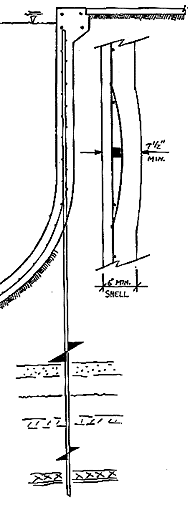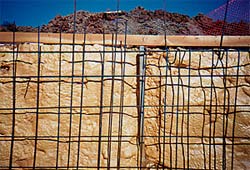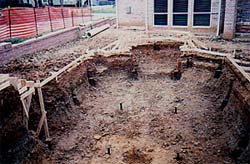Swimming Pools
A ‘standard’ gunite shell is six (6) inches thick, with #3 rebars – 10 inches on centers each way.
Add one #3 around the back to reduce cracking. Space at 10″ intervals.
The standard CHANCE Helical Anchor Stem is 1-1/2″ square. Other shaft thicknesses are available, such as 1-1/4″ and 1-3/4″
A shell will easily crack when the steel is placed so that the concrete coverage is reduced. Use a shovel to enlarge the area where the anchor stem is located so that a minimum of at least (3½) inches of gunite is placed between all steel and the soil.
This anchor can also be installed where a pool has shifted after it was built. Shifting includes soil swelling under the pool or some soft soil settlement. Where pools are built on hillsides, soil creep in the form of slow landslides will also shift a pool. Dig down alongside the outside of the shell to expose the back of the gunite. Install the CHANCE anchors adjacent to the shell and bolt the anchor firmly to the gunite using anchor bolts.

These anchors are far superior to drilled concrete shafts where swelling soil is found or where soft underlying fills have been placed. The steel shaft will not expand or contract from curing the way a concrete drill shaft does during the heat of the hydration or curing period. In addition, it is much easier to turn the steel anchor into the clay soil or into an uncompacted fill. Drilled concrete shafts are better where the soil is very hard or where rock seams are present in a non-swelling strata. Each type has its own particular suitable place in construction. Consult with a geotechnical soil engineer and a structural engineer to properly place the anchors.





